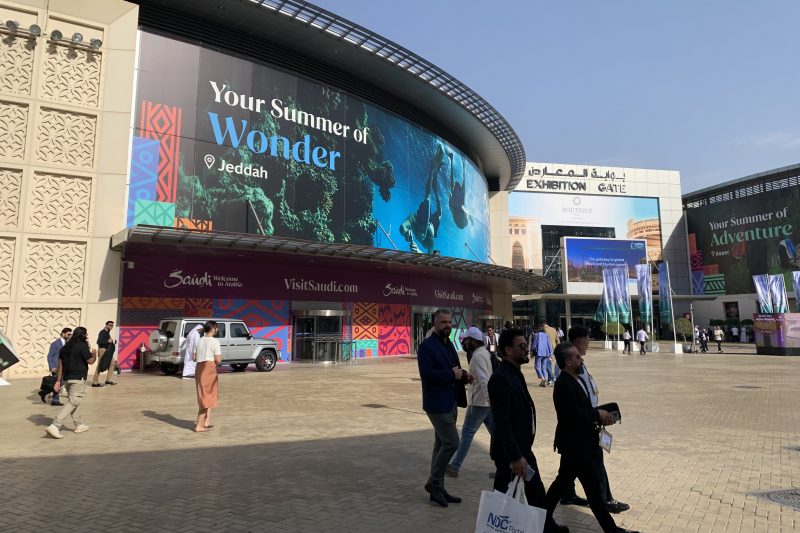
Arabian Travel Market Dubai – May 2024
In 2024 we can begin to see a clear picture of the post-pandemic Chinese outbound travel market, beyond the early days of reopening. Compared to 2019, how have preferences and consumer behavior changed? Is China’s economic situation holding back tourist spending? What is driving destination choice? And what are the biggest opportunities now and looking to the future?
At Arabian Travel Market Dubai this 6-8 May, we spoke to hotels, destinations, airlines, retailers, and other tourism businesses from Western Europe to Southeast Asia to find the answers to these key questions for the travel industry.

Who is the Chinese traveler of 2024?
The concept of “the Chinese traveler” was already unhelpful before the pandemic, and it’s even less applicable today. This is an extremely diverse and segmented market. This creates opportunities for different kinds of destinations and businesses, and requires additional effort in getting to know the market profiles and segments that are most relevant for you.
In Bahrain, Chinese visitors tend to be individual business travelers, says Yasemin Vardarli from the Hilton Bahrain. But this could be set to change with the launch of new Gulf Air flights to China this month. At the Renaissance Kuala Lumpur Hotel and Four Points Kuala Lumpur City Centre, China is one of the top markets, driven by FITs and families traveling for leisure, says Complex Director of Sales & Marketing, Rosidah Abdullah. At Italy’s Fidenza Village, shoppers now tend to travel individually or in small groups, says Stefano Rizza, Senior International Markets Manager.
Generally speaking, there is a trend away from group travel and towards FIT. But group travel still holds opportunities. Most impressively, the Concorde Hotel Shah Alam, Malaysia is once again filling rooms with series tours of four to five coachloads of Chinese tourists, says Director of Sales & Marketing Amilia Alias. In Astana, the Kazzhol Hotel gets groups of 20 to 30 Chinese guests twice a week. While he says FIT is on the rise, Stephen Su from the Swiss-Garden Hotel Bukit Bintang, Kuala Lumpur, also shares that Chinese corporate groups can fill up to 150 rooms.

Posing for photos at the Souk Al Bahar
Away from the ATM exhibition, the diversity of the Chinese tourism market was evident in the Dubai Mall and Dubai International Airport. Older women traveling in groups spoke to everyone around them – regardless of nationality – in Mandarin. Young women in trendy fashions posed for Xiaohongshu photos in front of the Dubai Fountain. Families with young children and designer clothes browsed the shops, buying confectionery and Emirates football merchandise.
What motivates their destination choices?
A diverse market will obviously also have diverse motivations for travel, but there are some strong commonalities. Specifically, these are shopping and food.
Chinese travelers are “all about food, shopping, and gambling” says Alias, speaking about the large series tours she hosts in Shah Alam, Malaysia, around 60% of whom are traveling outside of China for the first time. They’re particularly interested in buying local coffee, she says. Alias further explains that Chinese groups love staying in Shah Alam city for its many shopping malls and attractions, including the Shah Alam grand mosque, which the hotel overlooks.

Luxury travelers in Milan fit a very different market profile, but here again, shopping, food, and local products are key experiences, says Fidenza Village’s Rizza. He mentions a couple from Shanghai on their honeymoon just the week before, who followed their outlet shopping with a visit to the Parmesan cheese factory, and then a Michelin-starred restaurant for dinner.
“They are interested in shopping and culture, gastronomy and flamenco,” says Ana Sostres from Madrid Destino, explaining that Chinese visitors love historical restaurants and VIP shopping experiences. Even in Kazakhstan, Yulia from the Kazzhol hotel lists shopping alongside kayaking and mountain climbing as the top activities for Chinese tourists.
One essential influence on Chinese travelers’ destination choices is flight connectivity. Good connectivity is driving the growth of the Chinese market in Kazakhstan and market recovery in Madrid. Malaysia’s AirAsia delivers visitors from all over China to Kuala Lumpur and Penang, where recovery is accelerating – but not to Langkawi, where the recovery is on a slower track, according to staff from the Westin Langkawi. Although Azerbaijan is visa-free for Chinese visitors, Onur Hakyemez at the Ritz-Carlton Baku laments that lack of flight connectivity limits the market to small numbers of FITs. Meanwhile, hotels in Bahrain eagerly await Gulf Air’s new flights from Guangzhou and Shanghai.
How are they spending?
Amid continued market uncertainty, are Chinese consumers cutting back on travel expenses? Based on industry reports, Dragon Trail’s own research, and our conversations at ATM, our conclusions are:
– Chinese consumers are prioritizing outbound travel as an expenditure category
– They are not cutting back on shopping overseas, and also still prioritizing dining
– They are highly price conscious when it comes to hotels, and this benefits mid-range hotels in destinations with strong Chinese tourism recovery and/or market growth
At Fidenza Village, average spend per person by Chinese shoppers is up by 30% compared to pre-pandemic, shares Rizza. This is driven by the shift from group travel to higher-spending FITs, and is a trend seen across Europe and Asia, according to data from both GlobalBlue and Alipay. These post-pandemic Chinese shoppers aren’t just looking for the most famous brands anymore, says Rizza, but have turned their attention to more niche, Italian brands too. In Madrid, El Corte Ingles’ attentions towards the Chinese market are paying off, says Ana Sostres from Destino Madrid. The department store offers an additional discount for Chinese passport holders, and has introduced a special VIP shopping floor just for Chinese consumers. With its collection of all the biggest brands, luxury retailer Galeria Canelejas is a popular shopping destination in central Madrid, says Sostres, and Chinese travelers also enjoy outlet shopping outside the city center.
Another area where Chinese travelers are treating themselves is flights. ForwardKeys data from April 2024 showed that Q2 bookings for premium seats from China to Europe were only 3% below 2019’s levels, compared to -48% for economy seats. Premium seat bookings were ahead of pre-pandemic levels for many Euopean cities, including Geneva (+105%), Madrid (+49%), Paris (+18%) and Milan (+5%). Nina Tan, Director of Sales at the Hard Rock Hotel Penang, says that the Chinese are “big spenders” who tend to book first and business class seats.

Dragon Trail’s Sienna Parulis-Cook on stage at ATM as part of a panel discussion on Chinese outbound tourism
Chinese travelers might be splashing out on shopping and airfare, but when it comes to accommodation, they’re more conservative. In Dragon Trail’s spring 2024 Chinese Traveler Sentiment Survey, 65% of Chinese travelers said they would opt for mid-range or budget hotels on their next outbound trip. The St. Regis Astana, for example, says they see more growth in the Chinese market for mid-range hotels rather than their property. In Kuala Lumpur, the lead time for hotel bookings is shorter now, says Swiss-Garden Hotel’s Stephen Su, since price-sensitive travelers are spending more time to compare hotels and look for the best deals
However, the Chinese market is also very brand loyal and brand aware when it comes to hotels, points out Rosidah Abdullah from the Renaissance Four Points Kuala Lumpur, and loyalty programs like Marriott Bonvoy can have a significant impact on Chinese traveler choices.
What is the potential?
When Amilia Alias from the Concorde Hotel Shah Alam told us about her hotel’s Chinese guests, it felt like we’d traveled 15 years into the past. More than half are first-time travelers, she says. They travel in groups of four or five coaches on tours of Malaysia and Singapore. Print advertising is extremely effective for reaching them. This sounds like the early days of Chinese outbound tourism, but it also says a lot about the future of the market.
On one hand, the market has become increasingly independent, experienced, and sophisticated. Chinese travelers buy niche Italian brands and go on private tours of local cheese factories. On the other, there are still enormous numbers of Chinese who have been waiting to take their first-ever outbound trip. This makes understanding the customer and knowing how to market to them more complicated than ever. But there is huge potential to tap into with the right approach.
Contact Dragon Trail directly to discuss your approach and strategy for the China market, and work with us to develop a bespoke and targeted Chinese tourism marketing plan for 2024 and beyond.
Sign up for our free newsletter to keep up to date on our latest news
We do not share your details with any third parties. View our privacy policy.
This website or its third party tools use cookies, which are necessary to its functioning and required to achieve the purposes illustrated in the cookie policy. If you want to know more or withdraw your consent to all or some of the cookies, please refer to the cookie policy. By closing this banner, scrolling this page, clicking a link or continuing to browse otherwise, you agree to the use of cookies.